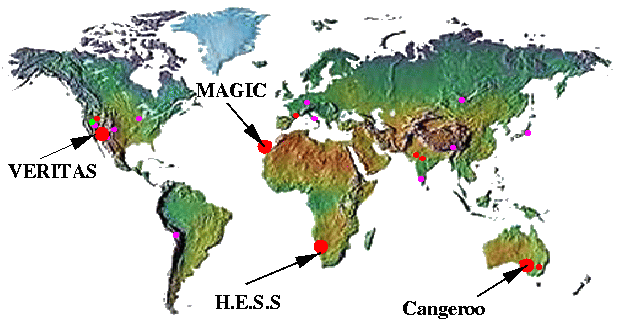
H·E·S·S· overview
H·E·S·S· ( High Energy Stereoscopic System) ist a next generation project of imaging atmospheric Cherenkov telescopes (IACT) used for TeV-gamma-astronomie in the GeV/TeV energy regime which is located near the Gamsberg in Namibia in 1800 about a.s.l. The name of the project reminds to Viktor Hess who got the Nobel-Price in 1936 for the discovery of the cosmic radiation.
Using one or more IACTs (combined to a stereoscopic system) one is able to record the Cherenkov light which is emitted in a small angle relatively to the trajectory of very high energy charged particles (coming from the universe) and secondary charged particles (of the hereby emerging extended air shower) penetrating the earth's atmosphere. The spectral maximum of the Cherenkov light lies between optical and ultra violett wavelength's. Together with Monte Carlo simulations one is able to reconstruct the energy (20 %) and the direction (<0.1 deg) of the primary particle of a corresponding air shower which allows the realisation of TeV gamma astronomy . This technique has been successfully used by many of the Cherenkov telescope experiments of the last generation, whereas the HEGRA experiment established the use of more than one telescopes in a stereoscopic system which allowed an significant improvement of the energy and direction reconstruction.
In the first state the H·E·S·S· project contains four IACTs combined in an stereoscopic system located on a square with side length of about 100m. One H·E·S·S· telescope (see the picture on the right) has a mirror diameter of 13 meters which corresponds to an area of more than 100 m 2 . The collected Cherenkov light is measured in a photo multiplier (PM) camera consisting of a matrix of 960 photomultiplier pixels. With this kind of camera it is possible to record an image of the Cherenkov light of an extended air shower (EAS). The advantage of recording images of one shower with more than one telescope from different points of view is comparable to the estimation of distances of objects by watching them with two eyes: The stereoscopic observation of air showers allows a three dimensional reconstruction of its orientation in the atmosphere. The whole array of four telescopes has an energy-threshold of about 100 GeV and an angular resolution of < 0.1 deg for a single event.
The main goal of the investigations with HESS is the exploration of the nonthermal universe, i.e. the production and interaction of high-energy particles in the universe (see H·E·S·S· physics ). Indeed, the acceleration of this radiation is yet not understood completely. The site of the telescope array gives the posibility to look into the galactic-center were many wide spread source regions are located. On the other hand there will be the possibility to search about the anhillation radiation of exotic paricles like Neutralinos .

